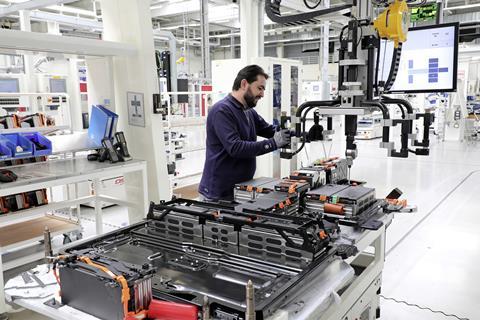
Inside Volkswagen’s battery logistics
Volkswagen Group Components has developed a standardised, returnable container for the safe delivery of lithium battery cells and assembled modules in support of its ambitious electric vehicle goals leading up to 2030
Towards the end of 2020 Volkswagen developed a special returnable container that can be used both for the shipment of lithium-ion battery cells and assembled battery modules. The containers, which were based on a propriety concept developed by the Volkswagen Group Components division and produced in collaboration with various (unnamed) partners, form part of an overall zero-emission sustainability strategy at the carmaker.
The containers are currently used to move battery cells from the supplier LG Chem in Wroclaw, Poland by rail into the VW Group Components plant in Brunswick, Germany. The same containers are also used to move completed battery systems built there to VW’s plant in Zwickau, again by rail.

“The containers are optimised for delivery by train, which has an essential impact to achieve the goals for CO2-neutral logistic chain,” said a spokesperson for VW Group Components. VW has said previously that since 2017 it has been able to reduce carbon emissions at Zwickau by 60% or more than 100,000 tonnes per year.
Brunswick will be supplying 500,000 battery systems a year for delivery to Zwickau at full production (as well as running gear components, and front and rear axles), making the choice of returnable containers a wise one.
The Zwickau plant is also now the first facility in the VW network making only electric vehicles, in the forms of the ID.3 electric hatchback and the ID.4 electric SUV. However, the Emden plant in Germany will begin making the ID.4 next year, as will the Chattanooga plant in the US, opening the potential for the further deployment of the new containers.
Thermoplastic safety
The dimensions of the container that VW Group Components has developed are 1.8 x 1.5 x 2.5 metres, providing a total capacity for 105 cell modules or seven battery systems respectively. They consist of seven frames, with a base pallet made of structural steel and supporting sheets made of the thermoplastic polymer, ABS (Aerylonitrile Butadiene Syrene).
ABS is a non-conductive, thermoplastic, that has high impact resistance to shock and vibration, and provides protection against heat and chemicals. That makes it good for moving lithium-ion batteries and materials as they are liable to ignition when damaged and categorised as a Class 9 Dangerous Good under the United Nation’s ADR treaty governing the international carriage of dangerous goods.

The principal safety risk when moving lithium batteries relates to thermal runaway, when an increase in temperature caused by a short-circuit or damage to the cells results in fire, explosions and the release of toxic and corrosive materials. It can also cause electric shock and the release of high-velocity projectiles from the cell.
ABS provides protection for the materials to avoid such damage and also a good level of containment should there be a thermal runaway incident. At the same time, ABS is also lightweight and recyclable, fitting in with VW’s overall sustainability strategy.
Automated delivery
The systems for loading and unloading the containerised batteries at Zwickau and Brunswick are highly automated, something VW said was “an essential prerequisite for efficient battery assembly” at the German plants. The loading cars at Brunswick and Zwickau have an empty weight of about 25 tonnes and travel on dedicated tracks beside the trains. They lift the special containers with battery modules or battery systems into or out of the rail cars automatically. On delivery to Zwickau the batteries are stored sequenced and lined up with conveyor technology – a first for the automotive industry according to VW. That system is combined with the use of fully electric 40-tonne trucks for internal transport within the factory.
Among the other notable logistics developments at Zwickau are the use of a virtual acceptance system for the containers and the use of fully digital and automated logistics retrieval and control systems.
In terms of the virtual acceptance system, it is no longer necessary to work with real parts and prototype containers at VW anymore because the whole process can be done virtually. Once the digital twin of the container and parts are tested, work can start immediately on the production of the containers, which saves time and materials.

“The containers are part of a holistic logistic concept – from our suppliers [through] VW Brunswick [and] to VW Zwickau – with fully automated loading and unloading processes in both VW plants,” said VW’s spokesperson. “Therefore, we closely worked together within the Volkswagen Group to exploit the most possible synergies.”
Five trains a week are currently running between Brunswick and Zwickau, with more planned in the future as EV production increases at the plant. Each train takes about five hours to load and unload.
To add to the sustainability goals, VW is in the process of switching all the materials, parts and vehicles it moves in Germany with state run rail provider Deutsche Bahn (DB) to green electricity. Currently 95% of VW freight movements carried by DB Cargo in Germany are accounted for by power generated by wind farms and hydropower plants. Bringing the figure up to 100% will save more than 26,700 tons of CO2 emissions annually, according to the carmaker.






